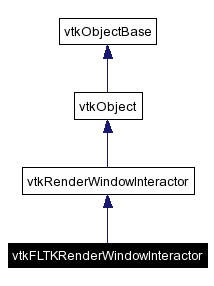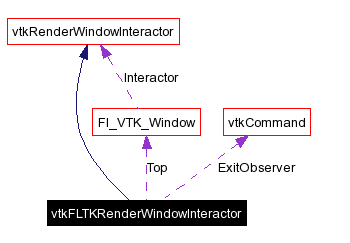
#include <vtkFLTKRenderWindowInteractor.h>
Inheritance diagram for vtkFLTKRenderWindowInteractor:


vtkFLTKRenderWindowInteractor is a convenience object that provides event bindings to common graphics functions. For example, camera and actor functions such as zoom-in/zoom-out, azimuth, roll, and pan. IT is one of the window system specific subclasses of vtkRenderWindowInteractor. Please see vtkRenderWindowInteractor documentation for event bindings.
Definition at line 46 of file vtkFLTKRenderWindowInteractor.h.
Public Member Functions | |
| vtkTypeRevisionMacro (vtkFLTKRenderWindowInteractor, vtkRenderWindowInteractor) | |
| void | PrintSelf (ostream &, vtkIndent) |
| virtual void | Initialize (void) |
| Initializes the event handlers. | |
| int | CreateTimer (int timerType) |
| Add a timeout to the event loop for this instance. | |
| int | DestroyTimer (void) |
| Returns 1 without ant other effects. | |
| void | OnTimer (void) |
| Invoke a timer event for this instance. | |
| virtual void | Start (void) |
| Start the FLTK event loop. | |
| virtual void | GetMousePosition (int *x, int *y) |
| Get the mouse position by querying the window server. | |
| void | SetExitObserver (vtkCommand *command) |
Set the command executed on receiving an ExitEvent event. | |
| void | SetExitObserverToDefault (void) |
| Reset the exit command to the default. | |
| virtual void | SetWidget (Fl_VTK_Window *window) |
| Specify Fl_VTK_Window (FLTK "peer" class widget) to use for interaction. | |
| Fl_VTK_Window * | GetWidget (void) const |
| Specify Fl_VTK_Window (FLTK "peer" class widget) to use for interaction. | |
| virtual void | SetTopLevelShell (Fl_Window *parent) |
| This method will store top level shell (parent) widget for the interactor. | |
| Fl_Window * | GetTopLevelShell (void) const |
| This method will store top level shell (parent) widget for the interactor. | |
Static Public Member Functions | |
| vtkFLTKRenderWindowInteractor * | New (void) |
Protected Member Functions | |
| vtkFLTKRenderWindowInteractor (void) | |
| ~vtkFLTKRenderWindowInteractor () | |
| void | Timer (void *) |
Static Protected Member Functions | |
| void | TimerCallback (void *) |
Protected Attributes | |
| Fl_VTK_Window * | Top |
| Fl_Window * | TopLevelShell |
| int | OwnTop |
| vtkCommand * | ExitObserver |
|
|
|
|
|
|
|
|
Add a timeout to the event loop for this instance.
Reimplemented from vtkRenderWindowInteractor. |
|
|
Returns 1 without ant other effects.
Reimplemented from vtkRenderWindowInteractor. |
|
||||||||||||
|
Get the mouse position by querying the window server.
Reimplemented from vtkRenderWindowInteractor. |
|
|
This method will store top level shell (parent) widget for the interactor. This method and the method invocation sequence applies for: 1 vtkRenderWindow-Interactor pair in a nested widget hierarchy multiple vtkRenderWindow-Interactor pairs in the same top level shell It is not needed for 1 vtkRenderWindow-Interactor pair as direct child of a top level shell multiple vtkRenderWindow-Interactor pairs, each in its own top level shell The method, along with EnterNotify event, changes the keyboard focus among the widgets/vtkRenderWindow(s) so the Interactor(s) can receive the proper keyboard events. The following calls need to be made: vtkRenderWindow's display ID need to be set to the top level shell's display ID. vtkFLTKRenderWindowInteractor's Widget has to be set to the vtkRenderWindow's container widget vtkFLTKRenderWindowInteractor's TopLevel has to be set to the top level shell widget note that the procedure for setting up render window in a widget needs to be followed. See vtkRenderWindowInteractor's SetWidget method. If multiple vtkRenderWindow-Interactor pairs in SEPARATE windows are desired, do not set the display ID (Interactor will create them as needed. Alternatively, create and set distinct DisplayID for each vtkRenderWindow. Using the same display ID without setting the parent widgets will cause the display to be reinitialized every time an interactor is initialized), do not set the widgets (so the render windows would be in their own windows), and do not set TopLevelShell (each has its own top level shell already). Definition at line 134 of file vtkFLTKRenderWindowInteractor.h. |
|
|
Specify Fl_VTK_Window (FLTK "peer" class widget) to use for interaction. This method is one of a couple steps that are required for setting up a vtkRenderWindowInteractor as a widget inside of another user interface. You do not need to use this method if the render window will be a stand-alone window. This is only used when you want the render window to be a subwindow within a larger user interface. In that case, you must tell the render window what X display id to use (should probably be fl_display), and then ask the render window what depth, visual and colormap it wants (should probably use Fl::gl_visual(), Fl_Gl_Window::mode(), and/or Fl_Gl_Window::can_do()). Then, you must create an FLTK top level window with those settings. Then you can create the rest of your user interface as a child of the top level window you created. Eventually, you will create a Fl_VTK_Window to serve as the rendering window. You must use the SetWidget method to tell this Interactor about that widget. Definition at line 99 of file vtkFLTKRenderWindowInteractor.h. |
|
|
Initializes the event handlers.
Reimplemented from vtkRenderWindowInteractor. |
|
|
Reimplemented from vtkRenderWindowInteractor. |
|
|
Invoke a timer event for this instance.
|
|
||||||||||||
|
Reimplemented from vtkRenderWindowInteractor. |
|
|
Set the command executed on receiving an
|
|
|
Reset the exit command to the default.
|
|
|
This method will store top level shell (parent) widget for the interactor. This method and the method invocation sequence applies for: 1 vtkRenderWindow-Interactor pair in a nested widget hierarchy multiple vtkRenderWindow-Interactor pairs in the same top level shell It is not needed for 1 vtkRenderWindow-Interactor pair as direct child of a top level shell multiple vtkRenderWindow-Interactor pairs, each in its own top level shell The method, along with EnterNotify event, changes the keyboard focus among the widgets/vtkRenderWindow(s) so the Interactor(s) can receive the proper keyboard events. The following calls need to be made: vtkRenderWindow's display ID need to be set to the top level shell's display ID. vtkFLTKRenderWindowInteractor's Widget has to be set to the vtkRenderWindow's container widget vtkFLTKRenderWindowInteractor's TopLevel has to be set to the top level shell widget note that the procedure for setting up render window in a widget needs to be followed. See vtkRenderWindowInteractor's SetWidget method. If multiple vtkRenderWindow-Interactor pairs in SEPARATE windows are desired, do not set the display ID (Interactor will create them as needed. Alternatively, create and set distinct DisplayID for each vtkRenderWindow. Using the same display ID without setting the parent widgets will cause the display to be reinitialized every time an interactor is initialized), do not set the widgets (so the render windows would be in their own windows), and do not set TopLevelShell (each has its own top level shell already). |
|
|
Specify Fl_VTK_Window (FLTK "peer" class widget) to use for interaction. This method is one of a couple steps that are required for setting up a vtkRenderWindowInteractor as a widget inside of another user interface. You do not need to use this method if the render window will be a stand-alone window. This is only used when you want the render window to be a subwindow within a larger user interface. In that case, you must tell the render window what X display id to use (should probably be fl_display), and then ask the render window what depth, visual and colormap it wants (should probably use Fl::gl_visual(), Fl_Gl_Window::mode(), and/or Fl_Gl_Window::can_do()). Then, you must create an FLTK top level window with those settings. Then you can create the rest of your user interface as a child of the top level window you created. Eventually, you will create a Fl_VTK_Window to serve as the rendering window. You must use the SetWidget method to tell this Interactor about that widget. |
|
|
Start the FLTK event loop.
Reimplemented from vtkRenderWindowInteractor. |
|
|
|
|
|
|
|
||||||||||||
|
|
|
|
Definition at line 157 of file vtkFLTKRenderWindowInteractor.h. |
|
|
Definition at line 155 of file vtkFLTKRenderWindowInteractor.h. |
|
|
Definition at line 152 of file vtkFLTKRenderWindowInteractor.h. |
|
|
Definition at line 153 of file vtkFLTKRenderWindowInteractor.h. |
 1.3.7
1.3.7